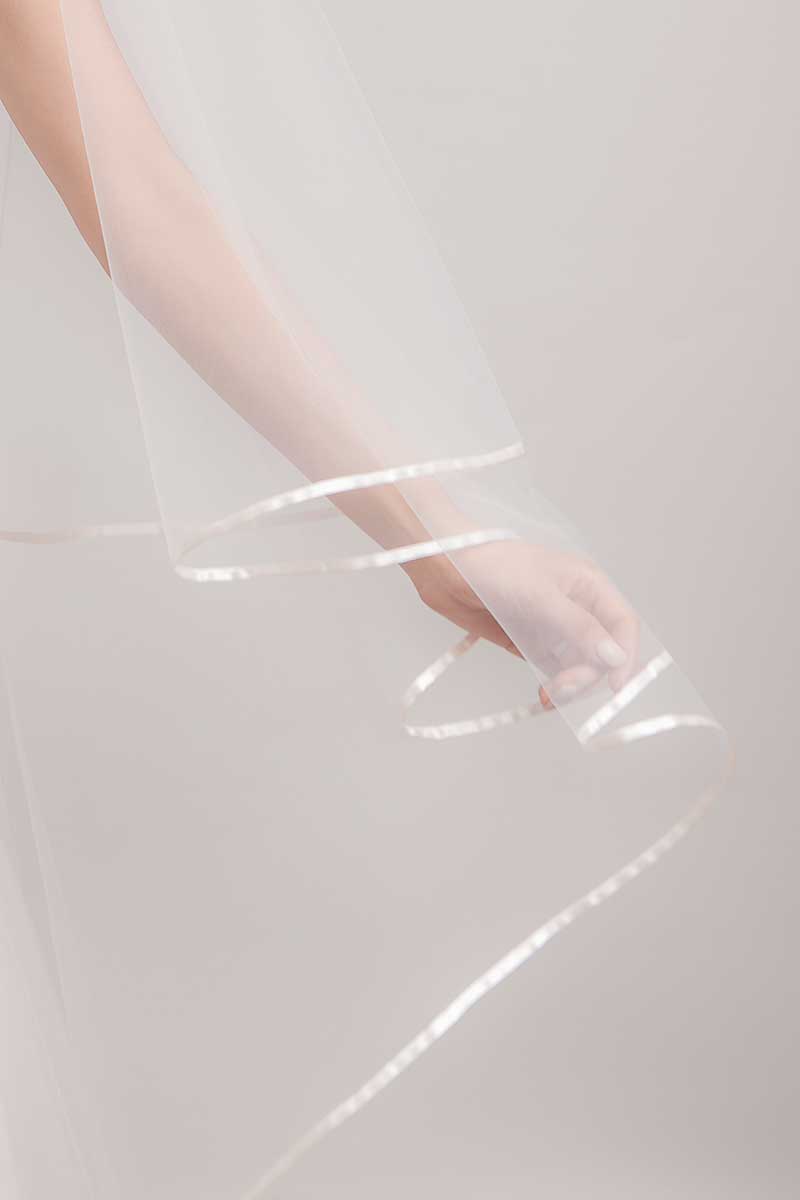
Picking the Right Veil Color for Your Dress
Many elements contribute to that match made in heaven between your dream wedding dress and the perfect veil. One of the most common things brides struggle with knowing how to pick the right veil color as they try to answer the question - white vs. ivory veil?
If you’ve done any amount of wedding shopping (online or in person), you likely discovered it can be hard to tell the difference – and there are many, many “shades of white”.
So how do you go about picking the right veil color for your dress? The answer may surprise you...
But first! A brief guide to veil color:
-
White- a pure, bright white. Pairs with pure white wedding gowns in all variety of fabrics, some of the most popular being crepe, taffeta, chiffon, and charmeuse.
A word of caution (!!) - very few wedding gowns are truly pure white, even some that are commonly referred to as "white".
For example, gowns made of silk are almost always slightly off-white, as are gowns referred to as "diamond white". -
Eggshell (also commonly called diamond white or natural) - a just barely "off-white" shade with no yellow undertone.
Works great against gowns made of natural silks, and other barely off-white tones; often referred to as natural, pearl, off-white, and silk white.
The perfectly neutral nature of eggshell means it tones against almost anything without clashing, making it a perfect choice if you're in doubt. Miranda Cathedral Veil with Satin Binding
Miranda Cathedral Veil with Satin Binding -
Ivory – a light off-white shade, with a warm, creamy undertone.
Ivory is a shade darker than eggshell and pairs perfectly gowns in the ivory, ivory/nude, ivory/blush family.
Fun fact! Over 99% of our veils are made in the ivory or eggshell colors, with all other tones combined making up less than 1%.
Unlike eggshell, which has almost no colour at all, when you scrunch ivory up in your hand, you can see a warmer, pale ivory cast. Peyton Chantilly lace mantilla veil
Peyton Chantilly lace mantilla veil
-
Dark Ivory- a deeper ivory shade, verging into the cream family. Dark ivory is a good fit for candlelight, cream or some champagne fabrics, like many silk mikados and brocades that have a deeper tone.
- Sorbet- a pretty, ballet slipper pink with a warm, slightly peachy undertone. Pairs beautifully with gowns that have blush pink accents, or some gowns with contrast nude underlinings.
"When in doubt, eggshell is a good choice. We send it to bridal fashion shoots all the time when we don't know the dress colors we'll be working with."
Now that you have the cliff notes, let's break it down further...
It's common for brides to be surprised when they discover that veils come in different colors. Let's face it though, unless a bride has played a key role helping a friend with their wedding ensemble, veil shopping is likely a first!

Not only do veils come in different colors, wedding gowns come in many colors as well, and designers tend to have their own names for their color palette.
In other words, natural, pearl, diamond white, silk white and eggshell are all more or less the same color- a "just-off-white" shade without any yellow undertone.
One designer’s “creme” could be the same as another designer’s “ivory” or “vanilla". Or, the “ivory” of 3 different designers, or even different fabrics within the same designer's collection, may vary in appearance.
Now for the reveal: the surprise answer to "how do I match my veil color to my wedding dress?" Well... you don't!
Yep, you really did just read that. I said don't bother matching your veil. Ok, well…not exactly ;)
What I mean to say is, the goal is for your veil to tone with your dress, not an exact color match.

Wait, what? So how does that work? Here's a couple of secrets:
Secret #1: Most tulle fabrics used for wedding veils intentionally have very little color. Since most veils have some gathering at the comb or "fullness" at the bottom.
For that reason, if the veil fabric has too much intensity in color, it would give a dark, "halo" effect at the top around your face where it's gathered together, or too much contrast against your dress at the bottom where it's fuller.
Most brides want their veil to have a sheer, ethereal effect that reveals the detail and silhouette of their dress.
Khrysia Cathedral Veil with Monogram
Secret #2: Bridal veils are usually very sheer, and are a light, open weave, so even the identical “color” in a gown fabric, like satin, for example, will appear slightly different due to the difference in texture and opacity.
That’s why we aim for a tonal match, not an exact color match. There are far more subtleties between bridal gown fabrics and coloration than in most tulle fabrics used for wedding veils.

5 Tips to Get the Perfect Veil Color for Your Dress
-
Know what you’re trying to match. If you know the designer name, style name, and color of your dress, that’s a great start. If you’re having a custom wedding dress made, know the name of the fabric, what it’s made of, and get a fabric swatch if possible.
-
Don’t rely on your screen for exact color. Screens do not provide an accurate representation of color. Many things impact how color appears online, and in photos, such as lighting, filters, etc.
Also, veils have very little color, so often different colors will appear to be the same online.
-
Ask for expert help. Most bridal salons or online wedding shops (including ours), will be familiar with top bridal designer color palettes.
They will know if Romona Keveza’s ivory duchesse is on the richer side, or if Pronovias nude reads more ivory in person when pairing a veil. An expert bridal stylist will be able to offer advice once you share details about your dress.
-
Remember to look for a tone that works with your dress. For all the different colors of wedding gowns, there’s only a handful of tulle colors widely in use. Refer to the veil color guide at the beginning of this article.
-
Follow this easy rule of thumb:
- For a bright, white gown, choose a white veil.
For other gown colors, start with this simple question: does your gown have any yellow undertone? - If your dress is off-white without any yellow undertone, choose a veil in eggshell.
- If your dress is off-white and has a slight yellow/warm undertone, choose an ivory veil.
- If you are still unsure of which color to choose, get a veil swatch. Most designers offer swatches at nominal cost. Getting a swatch may help to ease your mind choosing the perfect color.
"Remember, the goal is a tonal match between your veil & your gown."
There you have it! We hope this blog was helpful de-mystifying the many 'shades of white" & how to match them up! Feel free to contact us for help pairing the perfect veil with your dream dress.
Meanwhile, you can explore our collection of handcrafted wedding veils here.


